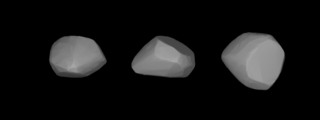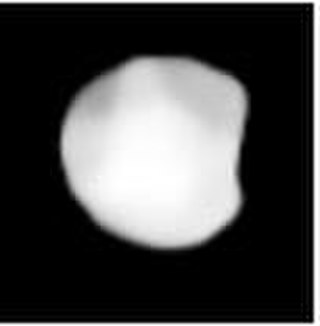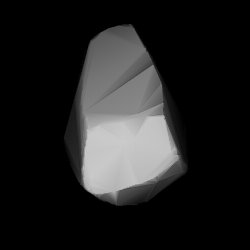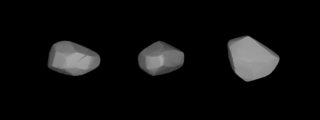
Maja is a carbonaceous background asteroid from the central regions of the asteroid belt, approximately 71 kilometers in diameter. It was discovered on 9 April 1861, by American astronomer Horace Tuttle at the Harvard College Observatory in Cambridge, Massachusetts, United States. The asteroid was named after Maia from Greek mythology.

Niobe is a stony Gallia asteroid and relatively slow rotator from the central regions of the asteroid belt, approximately 90 kilometers in diameter. It was discovered by the German astronomer Robert Luther on 13 August 1861, and named after Niobe, a character in Greek mythology. In 1861, the brightness of this asteroid was shown to vary by astronomer Friedrich Tietjen.

Aegle is a carbonaceous asteroid and the namesake of the Aegle family located in the outer regions of the asteroid belt, approximately 170 kilometers in diameter. It was discovered on 17 February 1868, by French astronomer Jérôme Coggia at the Marseille Observatory in southeastern France. The rare T-type asteroid has a rotation period of 13.8 hours and has been observed several times during occultation events. It was named after Aegle ("brightness"), one of the Hesperides from Greek mythology.

Ino is a large asteroid and the parent body of the Ino family, located in the central regions of the asteroid belt, approximately 150 kilometers in diameter. It was discovered on 1 August 1877, by French astronomer Alphonse Borrelly at Marseille Observatory in southern France, and named after the queen Ino from Greek mythology. The dark Xk-type asteroid has a rotation period of 6.15 hours.

Aquitania, provisional designation 1894 AZ, is a Postremian asteroid from the central regions of the asteroid belt, approximately 101 kilometers in diameter. Discovered by Fernand Courty at the Bordeaux Observatory in 1894, it was named for the French region of Aquitaine, the former province of Gallia Aquitania in the ancient Roman Empire.
1602 Indiana, provisional designation 1950 GF, is a stony Florian asteroid from the inner regions of the asteroid belt, approximately 8 kilometers in diameter.
3225 Hoag, provisional designation 1982 QQ, is a dynamical Hungaria asteroid from the innermost regions of the asteroid belt, approximately 5.5 kilometers in diameter. It was discovered on 20 August 1982, by American astronomer couple Carolyn and Eugene Shoemaker at the Palomar Observatory in California. The stony S/L-type asteroid has a short rotation period of 2.37 hours. It was named for American astronomer Arthur Hoag.
5653 Camarillo ( KAM-ə-REE-oh), provisional designation 1992 WD5, is a stony asteroid and near-Earth object of the Amor group, approximately 1.5 kilometers in diameter.

1335 Demoulina, provisional designation 1934 RE, is a stony Florian asteroid from the inner regions of the asteroid belt, approximately 7 kilometers in diameter. Discovered by Karl Reinmuth at Heidelberg Observatory in 1934, the asteroid was named after Prof. Demoulin, a Belgian astronomer at Ghent University. It has a slower-than average spin rate of nearly 75 hours.
2658 Gingerich, provisional designation 1980 CK, is a background asteroid and a suspected synchronous binary system from the outer regions of the asteroid belt, approximately 13 kilometers in diameter. It was discovered on 13 February 1980, by astronomers of the Harvard College Observatory at the George R. Agassiz Station near Harvard, Massachusetts, in the United States. The presumed carbonaceous C-type asteroid has a short rotation period of 2.9 hours. It was named after Harvard astronomer Owen Gingerich.
3844 Lujiaxi, provisional designation 1966 BZ, is a Henan asteroid from the central regions of the asteroid belt, approximately 15 kilometers in diameter. It was discovered on 30 January 1966, by astronomers at the Purple Mountain Observatory in Nanking, China. The asteroid was named after Chinese chemist Lu Jiaxi.
1355 Magoeba, provisional designation 1935 HE, is a Hungaria asteroid and a suspected contact-binary from the innermost regions of the asteroid belt, approximately 5 kilometers in diameter. It was discovered on 30 April 1935, by English-born, South African astronomer Cyril Jackson at the Johannesburg Observatory in South Africa. The asteroid is named for Magoeba, a tribal chief in the South African Transvaal Province.

3451 Mentor is a large Jupiter trojan from the Trojan camp, approximately 120 kilometers in diameter. It was discovered on 19 April 1984, by Czech astronomer Antonín Mrkos at the Kleť Observatory in the Czech Republic. The uncommon Jovian X-type asteroid is one of the largest Jupiter trojans and has a rotation period of 7.7 hours. It was named after Mentor from Greek mythology. Mentor, a man who was rich in horse at Pedaeus. He was the father of the spearman Imbrius, an ally of the Trojans.

1906 Naef is a stony vestoid asteroid from the inner regions of the asteroid belt, approximately 7 kilometers in diameter. It was discovered on 5 September 1972, by Swiss astronomer Paul Wild at Zimmerwald Observatory near Bern, Switzerland. It was later named after Swiss banker and amateur astronomer Robert A. Naef.
3406 Omsk, provisional designation 1969 DA, is a background asteroid from the central regions of the asteroid belt, approximately 15 kilometers in diameter. It was discovered on 21 February 1969, by Soviet astronomer Bella Burnasheva at the Crimean Astrophysical Observatory on the Crimean peninsula in Nauchnij. The possibly metallic M/X-type asteroid has a rotation period of 7.3 hours. It was named for the Russia city of Omsk.
2328 Robeson, provisional designation 1972 HW, is a background asteroid from the inner regions of the asteroid belt, approximately 13 kilometers in diameter. It was discovered on 19 April 1972, by astronomer Soviet–Russian Tamara Smirnova at the Crimean Astrophysical Observatory in Nauchnij, on the Crimean peninsula. It was named after American actor and singer Paul Robeson. The C/X-type asteroid has a rotation period of 18.6 hours.

1263 Varsavia, provisional designation 1933 FF, is an asteroid from the central region of the asteroid belt, approximately 40 kilometers in diameter. It was discovered on 23 March 1933, by Belgian astronomer Sylvain Arend at Uccle Observatory in Belgium. It is named for the city of Warsaw.
1689 Floris-Jan, provisional designation 1930 SO, is a stony asteroid and a slow rotator from the inner regions of the asteroid belt, approximately 16 kilometers in diameter. Discovered by Hendrik van Gent in 1930, it was named after a contest winner of an exhibition at Leiden Observatory.
(6382) 1988 EL, is a stony Hungaria asteroid from the inner regions of the asteroid belt, approximately 5 kilometers in diameter. It was discovered on 14 March 1988, by American astronomer Jeffrey Alu at the U.S. Palomar Observatory, California.
24827 Maryphil, provisional designation 1995 RA, is a stony Phocaea asteroid from the inner regions of the asteroid belt, approximately 6 kilometers in diameter. It was discovered on 2 September 1995, by American astronomer Timothy Spahr at the Catalina Station near Tucson, Arizona, who named it for his parents, Mary & Phil Spahr.









